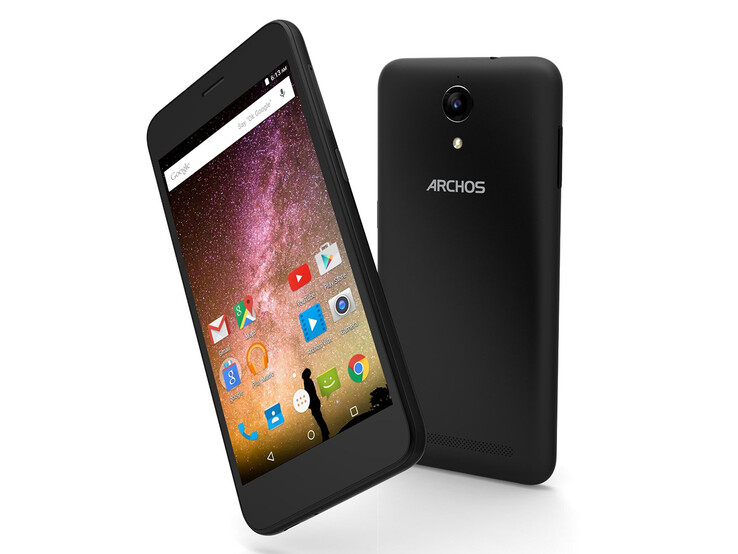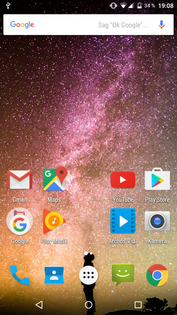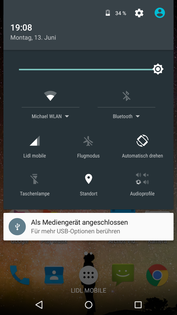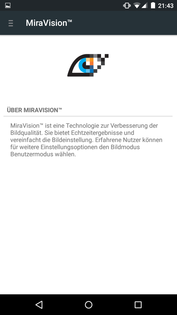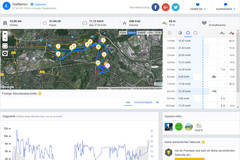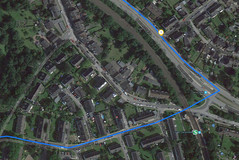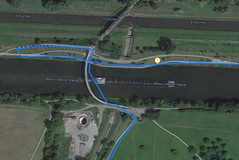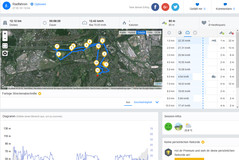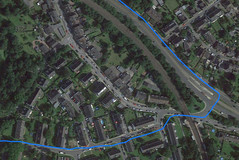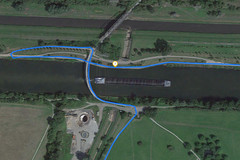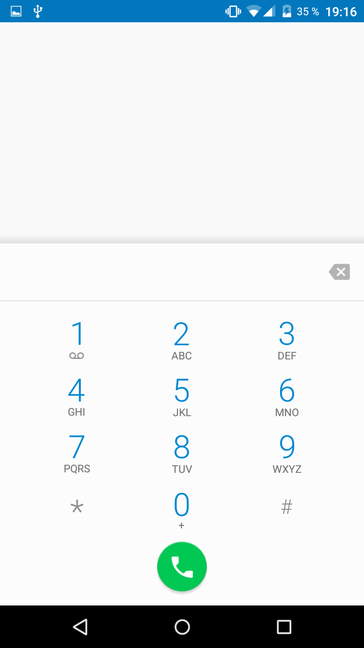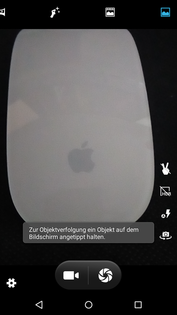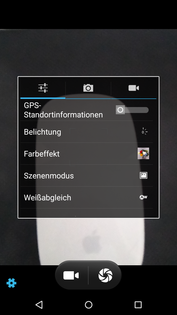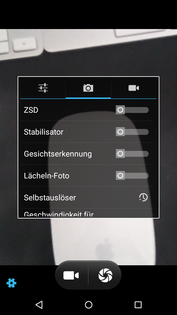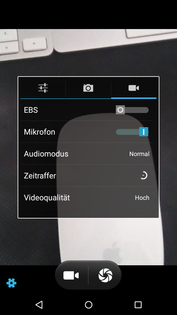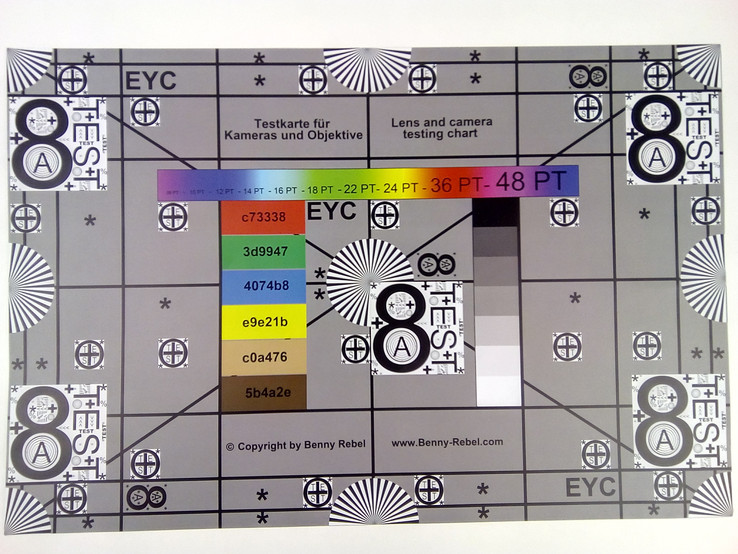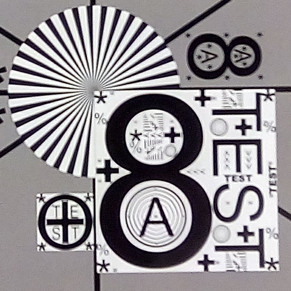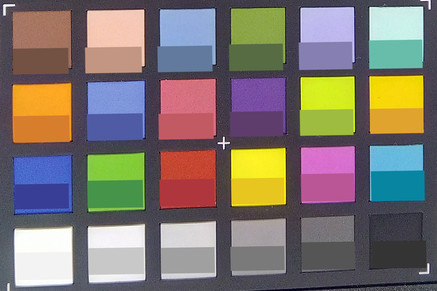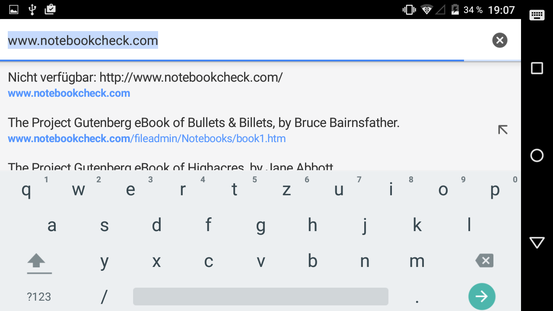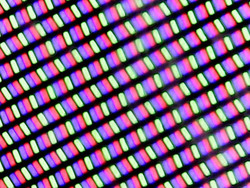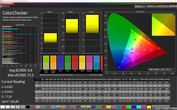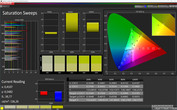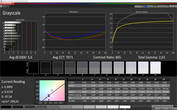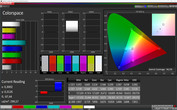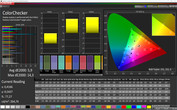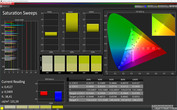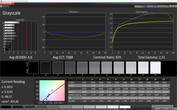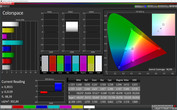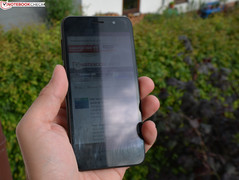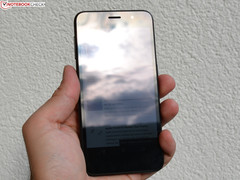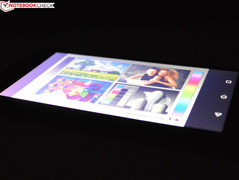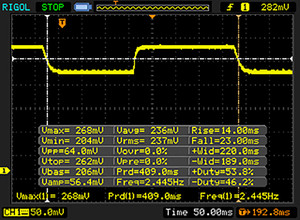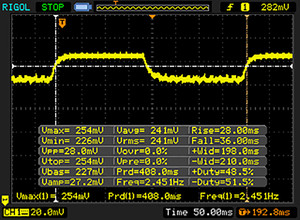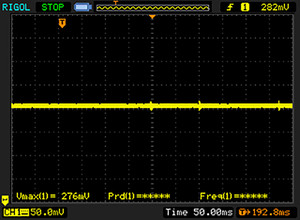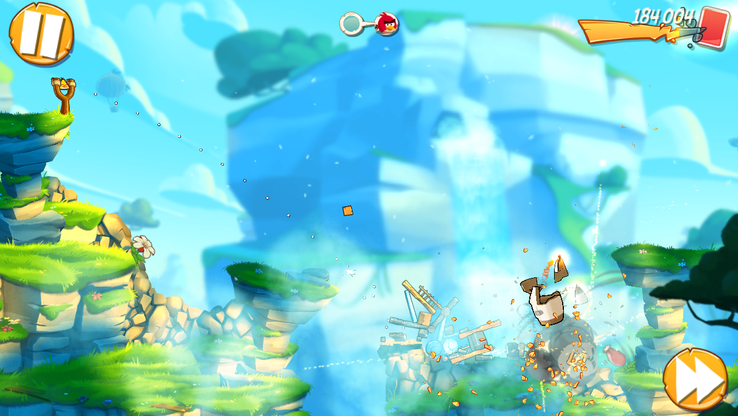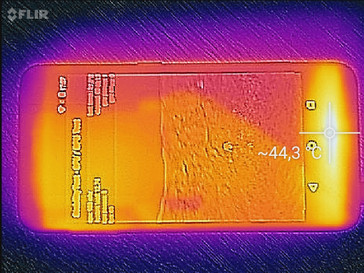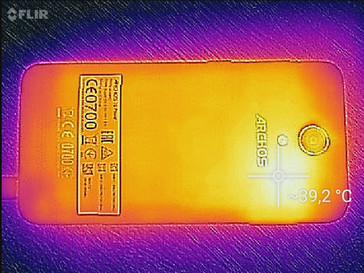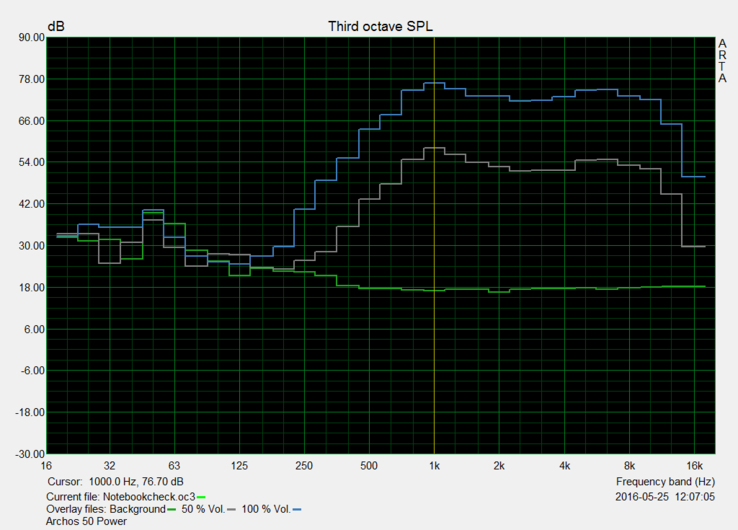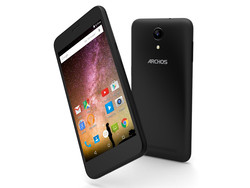Archos 50 Power Smartphone Review
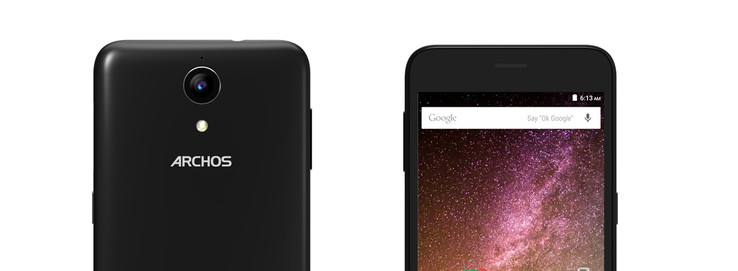
For the original German review, see here.
With the 50 Power, the French manufacturer Archos launches a 5-inch mid-range smartphone with an IPS HD panel and quad-core processor alongside 2 GB of working memory. The 16 GB of internal storage can be expanded via micro-SD card. Alternatively, Archos 50 Power supports dual-SIM, and LTE provides an up-to-date connectivity.
Archos' 50 Power has to compete against multiple rivals from the 150 Euro (~$167) price range. Among them we find some very decent smartphones. The direct field of opponents for this test is compiled as follows: UMi Touch, Microsoft Lumia 550, Leagoo Shark 1 and Coolpad Porto S.
Case
The matte-black casing of Archos' 50 Power is made of plastic, and Corning Gorilla Glass protects the 5-inch screen. The back soon looks a bit grimy as it is quickly covered with fingerprints; it is, however, easy to clean.
The review sample's size still makes a relatively handy impression. Only Coolpad's Porto S and Microsoft's Lumia 550 are even smaller. Together with the Microsoft's Lumia 550 it is the tallest handset in the comparison at 9.2 mm (0.36 in). The camera in the center protrudes a bit so that the casing rocks marginally when laid down.
All gaps are spaced evenly, and the trays for the micro-SIMs or micro-SD card have been fitted impeccably. However, the latter juts out slightly and palpably. The volume control and power button do not give much reason for complaint, either. Only their pressure points could be a bit more precise.
The handset fares quite well in terms of stiffness and it can hardly be twisted although it then creaks audibly. Medium pressure on the screen is enough to cause discolorations. The battery is fixed and cannot be replaced.
Connectivity
The entry-level MediaTek MT6735P quad-core SoC based on the ARM Cortex A53 only clocks at 1 GHz in contrast to the standard MT6735, and finds support in 2 GB of working memory. The system storage of 16 GB (gross: 10.08 GB) can be expanded by up to 32 GB according to the manufacturer. However, a 64 GB SanDisk Ultra memory card was identified without issues in the test. Unfortunately, apps could not be moved to the SD in the test. The micro-USB 2.0 port on the handset's lower edge can be used for recharging and data sharing. Furthermore, it supports USB OTG, and thus flash drives or peripherals like mice can be connected via an adapter. Wireless data transmission via Bluetooth 4.0 and Wi-Fi Direct is also possible, and an FM radio that can be used with the included stereo headset is also on board.
Software
Archos' 50 Power is based on the Android 5.1 Lollipop operating system. An update to a newer version has not yet been announced. Archos has not modified the system.
Archos' software tries to install third-party apps right after the smartphone's initial setup. The apps "Modern Combat 4 Zero Hour", "Office Suite", "Puzzle Pets" and "Spiderman Ultimate Power" are among these. Subsequently, the user only has 9.95 GB of storage of maximum 11.09 GB left, i.e. the system uses approximately 5 GB in Archos 50 Power. This installation process can be stopped and only the file manager and Archos' video player are installed, and the user then has 10.08 GB of storage available. Naturally, stock Android comes with the known Google applications like Chrome.
Communication & GPS
The dual-SIM smartphone connects to the Internet with up to two SIM cards - micro-SIM and nano-SIM. However, the user has to decide whether he wants to use a micro-SD card or the dual-SIM functionality. Only the first SIM slot supports LTE Cat.4 with transfer rates of up to 150 Mbit/s (downstream; 50 Mbit/s upstream). Furthermore, quad-band GSM and dual-band UMTS are present. The reception was acceptable in a rural area. The Wi-Fi module supports the 802.11 b/g/n standards in both the 2.4 GHz and 5.0 GHz networks. The connection quality was always sufficient at a distance of approximately 10 meters (~33 feet) to a Telekom Speedport router.
Archos' 50 Power uses A-GPS for localization. Satellites were found after only 30 seconds with an accuracy of five meters (~16 ft) near a window indoors. The precision improves to four meters (~13 ft) outdoors thanks to more satellites. We compared Archos' 50 Power with Garmin's Edge 500 bike computer to test the accuracy. The smartphone cuts the total route by 120 meters (about 400 ft) - a decent rate that allows occasional navigation.
Telephone & Call Quality
The call quality of Archos' 50 Power is characterized by slightly audible background noise. We did not observe any disruptions in the test. The speaker offers an acceptable volume, but the included headset is rather makeshift. The phone app corresponds to the unmodified stock Android design and provides all important features. Dual-SIM preference can also be set.
Cameras
The rear-facing primary camera in Archos' 50 Power has a resolution of 13 megapixels, and features an LED flash besides an auto focus. Videos are recorded in 720p. The webcam has a resolution of 2 megapixels.
The camera app provides multiple settings, for example white balance, ISO rate or even an image stabilizer. The front camera's photos disappoint with little details, pale colors and relatively visible image noise. The primary camera does a considerably better job. However, its color reproduction is not really accurate and also quite pale. Furthermore, the sensor's light sensitivity is somewhat weak and thus details seem a bit blurry. The sharpness primarily decreases visibly toward the edges. Its low-light performance is mixed; although the brightness is acceptable, details blur and image noise increases sharply. Nevertheless, it is acceptable for occasional snapshots.
Accessories & Warranty
In addition to the smartphone, Archos includes a USB charger alongside its cable, SIM tool, stereo headset, quick start guide and warranty conditions in the box. Archos also offers diverse optional universal accessories, such as micro-SD cards or power supplies, for the 50 Power. The manufacturer ships the 50 Power with a 2-year warranty.
Input Devices & Handling
The capacitive multi-touchscreen detects up to five fingers at a time. Its gliding qualities are decent. Inputs are identified reliably up to the edges. The Android buttons are implemented as onscreen icons and thus reserve a part of the screen. The physical keys respond reliably and have a decent pressure point. The installed keyboard corresponds to stock Android. Of course, other keyboards from Google's Play Store can be installed optionally.
Display
The 5-inch IPS panel in Archos' 50 Power has a resolution of 1280x720 pixels in a 16:9 format. That equals a pixel density of 294 PPI. The rivals Leagoo's Shark 1 and UMi's Touch have more to offer with Full HD resolution. Therefore, contents sometimes do not look quite as razor-sharp in Archos' 50 Power. This is not restrictive in everyday use.
The maximum brightness on a pure white image is 348 cd/m². An average of approximately 311 cd/m² is achieved and 304 cd/m² with enabled sensor. The brightness drops to 300 cd/m² when dark and bright image sections are distributed evenly (APL50). The illumination of just 83 percent is relatively poor; only Leagoo's Shark 1 presents a slightly more heterogeneous illumination.
| |||||||||||||||||||||||||
Brightness Distribution: 83 %
Center on Battery: 304 cd/m²
Contrast: 981:1 (Black: 0.31 cd/m²)
ΔE ColorChecker Calman: 5.9 | ∀{0.5-29.43 Ø4.77}
ΔE Greyscale Calman: 4.6 | ∀{0.09-98 Ø5}
Gamma: 2.51
CCT: 7088 K
| Archos 50 Power IPS, 1280x720, 5" | UMI Touch IPS, 1920x1080, 5.5" | Microsoft Lumia 550 IPS, 1280x720, 4.7" | Leagoo Shark 1 IPS, 1920x1080, 6" | Coolpad Porto S IPS, 1280x720, 5" | |
|---|---|---|---|---|---|
| Screen | -7% | -0% | -29% | -20% | |
| Brightness middle (cd/m²) | 304 | 424 39% | 536 76% | 471 55% | 407 34% |
| Brightness (cd/m²) | 311 | 415 33% | 535 72% | 465 50% | 403 30% |
| Brightness Distribution (%) | 83 | 91 10% | 95 14% | 82 -1% | 92 11% |
| Black Level * (cd/m²) | 0.31 | 0.54 -74% | 0.62 -100% | 0.9 -190% | 0.5 -61% |
| Contrast (:1) | 981 | 785 -20% | 865 -12% | 523 -47% | 814 -17% |
| Colorchecker dE 2000 * | 5.9 | 6.9 -17% | 5.81 2% | 7.1 -20% | 7.9 -34% |
| Colorchecker dE 2000 max. * | 14.3 | 10.9 24% | 12.3 14% | 17 -19% | 18.2 -27% |
| Greyscale dE 2000 * | 4.6 | 6.8 -48% | 7.72 -68% | 7.5 -63% | 8.9 -93% |
| Gamma | 2.51 88% | 1.99 111% | 2.18 101% | 2.23 99% | 2.46 89% |
| CCT | 7088 92% | 8131 80% | 8701 75% | 8261 79% | 8332 78% |
* ... smaller is better
On the other hand, Archos' 50 Power clearly outruns all of its rivals with a low black level of 0.31 cd/m² and the relatively high contrast of 981:1. Subjectively, the screen does a good job and content looks sharp and, thanks to the superb black level, quite appealing.
Among other things, different profiles are found in the menu item MiraVision of Archos' 50 Power. It enables customizing the reproduction to some extent.
We measured overall average rates with the photospectrometer and CalMAN analysis software in both standard and vivid display mode. Clear aberrations to the sRGB color space are visible especially in the green-yellow field. In standard mode, we measure an average of 5.9 (colors) and 4.6 (grayscale). The latter noticeably deviates from the target in the darker fields, and exhibits a minor bluish cast. Some colors are also too saturated. Although the image makes a somewhat cool impression, it is quite attractive particularly in vivid mode.
The brightness is sufficient for decently reading the screen even outdoors. However, the highly reflective surface naturally makes it difficult in direct light. Thanks to the IPS technology, the viewing angles are very good; only a minor brightness loss is visible when tilting the screen. Clouding in very dark images stays within acceptable limits.
Display Response Times
| ↔ Response Time Black to White | ||
|---|---|---|
| 37 ms ... rise ↗ and fall ↘ combined | ↗ 14 ms rise | |
| ↘ 23 ms fall | ||
| The screen shows slow response rates in our tests and will be unsatisfactory for gamers. In comparison, all tested devices range from 0.1 (minimum) to 240 (maximum) ms. » 95 % of all devices are better. This means that the measured response time is worse than the average of all tested devices (20.2 ms). | ||
| ↔ Response Time 50% Grey to 80% Grey | ||
| 64 ms ... rise ↗ and fall ↘ combined | ↗ 28 ms rise | |
| ↘ 36 ms fall | ||
| The screen shows slow response rates in our tests and will be unsatisfactory for gamers. In comparison, all tested devices range from 0.165 (minimum) to 636 (maximum) ms. » 97 % of all devices are better. This means that the measured response time is worse than the average of all tested devices (31.6 ms). | ||
Screen Flickering / PWM (Pulse-Width Modulation)
| Screen flickering / PWM not detected | |||
In comparison: 53 % of all tested devices do not use PWM to dim the display. If PWM was detected, an average of 8081 (minimum: 5 - maximum: 343500) Hz was measured. | |||
Performance
The MediaTek MT6735P 64-bit capable quad-core SoC based on ARM Cortex A53 is situated among entry-level processors. In contrast to the MT6735, it clocks at just 1 GHz. The integrated ARM Mali-T720 MP4 graphics unit is responsible for graphic tasks. Subjectively, the available performance was always sufficient for this price range - not least thanks to the total of 2 GB of working memory. Although minor stutters were sometimes observed during multitasking, it did not affect the performance. However, it is almost always defeated by stronger rivals in the comparison field, and is only roughly on par with Coolpad's Porto S in this competition.
| AnTuTu v6 - Total Score (sort by value) | |
| Archos 50 Power | |
| Coolpad Porto S | |
| Leagoo Shark 1 | |
| UMI Touch | |
| Microsoft Lumia 550 | |
| Geekbench 3 | |
| 64 Bit Single-Core Score (sort by value) | |
| Archos 50 Power | |
| UMI Touch | |
| 64 Bit Multi-Core Score (sort by value) | |
| Archos 50 Power | |
| UMI Touch | |
| 3DMark | |
| 1280x720 offscreen Ice Storm Unlimited Score (sort by value) | |
| Archos 50 Power | |
| Coolpad Porto S | |
| Leagoo Shark 1 | |
| UMI Touch | |
| 1280x720 offscreen Ice Storm Unlimited Graphics Score (sort by value) | |
| Archos 50 Power | |
| Coolpad Porto S | |
| Leagoo Shark 1 | |
| UMI Touch | |
| 1280x720 offscreen Ice Storm Unlimited Physics (sort by value) | |
| Archos 50 Power | |
| Coolpad Porto S | |
| Leagoo Shark 1 | |
| UMI Touch | |
| 2560x1440 Sling Shot OpenGL ES 3.0 (sort by value) | |
| Archos 50 Power | |
| Leagoo Shark 1 | |
| UMI Touch | |
| 2560x1440 Sling Shot OpenGL ES 3.0 Graphics (sort by value) | |
| Leagoo Shark 1 | |
| UMI Touch | |
| 2560x1440 Sling Shot OpenGL ES 3.0 Physics (sort by value) | |
| Leagoo Shark 1 | |
| UMI Touch | |
| GFXBench (DX / GLBenchmark) 2.7 | |
| T-Rex Onscreen (sort by value) | |
| Archos 50 Power | |
| Coolpad Porto S | |
| Leagoo Shark 1 | |
| UMI Touch | |
| Microsoft Lumia 550 | |
| 1920x1080 T-Rex Offscreen (sort by value) | |
| Archos 50 Power | |
| Coolpad Porto S | |
| Leagoo Shark 1 | |
| UMI Touch | |
| Microsoft Lumia 550 | |
| GFXBench 3.0 | |
| on screen Manhattan Onscreen OGL (sort by value) | |
| Archos 50 Power | |
| Coolpad Porto S | |
| Leagoo Shark 1 | |
| UMI Touch | |
| 1920x1080 1080p Manhattan Offscreen (sort by value) | |
| Archos 50 Power | |
| Coolpad Porto S | |
| Leagoo Shark 1 | |
| UMI Touch | |
| GFXBench 3.1 | |
| on screen Manhattan ES 3.1 Onscreen (sort by value) | |
| Archos 50 Power | |
| Leagoo Shark 1 | |
| UMI Touch | |
| 1920x1080 Manhattan ES 3.1 Offscreen (sort by value) | |
| Archos 50 Power | |
| Leagoo Shark 1 | |
| UMI Touch | |
| PCMark for Android - Work performance score (sort by value) | |
| Archos 50 Power | |
| Coolpad Porto S | |
| Leagoo Shark 1 | |
| UMI Touch | |
The browser-based benchmarks also present a mixed impression. Archos' 50 Power is also surpassed by most rivals here. However, browsing via Chrome browser was possible without prolonged delays or loading times in routine use.
| Octane V2 - Total Score (sort by value) | |
| Archos 50 Power | |
| Coolpad Porto S | |
| Leagoo Shark 1 | |
| UMI Touch | |
| Microsoft Lumia 550 | |
| Mozilla Kraken 1.1 - Total (sort by value) | |
| Archos 50 Power | |
| Coolpad Porto S | |
| Leagoo Shark 1 | |
| UMI Touch | |
| Microsoft Lumia 550 | |
| JetStream 1.1 - Total Score (sort by value) | |
| Archos 50 Power | |
| Coolpad Porto S | |
| Leagoo Shark 1 | |
| UMI Touch | |
| Microsoft Lumia 550 | |
* ... smaller is better
In the storage benchmarks, the review sample can still outperform Coolpad's Porto S to some extent in sequential write and read of large blocks, but particularly UMi's Touch is far up front. It can catch up a bit again in reading small data blocks (4K), and only lets Leagoo's Shark 1 pass. Unfortunately, we could not test the integrated card reader since AndroBench did not identify our reference card. However, the review sample's performance is subjectively on a good level; prolonged waiting times were not observed.
| AndroBench 3-5 | |
| Random Write 4KB (sort by value) | |
| Archos 50 Power | |
| Coolpad Porto S | |
| Leagoo Shark 1 | |
| UMI Touch | |
| Random Read 4KB (sort by value) | |
| Archos 50 Power | |
| Coolpad Porto S | |
| Leagoo Shark 1 | |
| UMI Touch | |
| Sequential Write 256KB (sort by value) | |
| Archos 50 Power | |
| Coolpad Porto S | |
| Leagoo Shark 1 | |
| UMI Touch | |
| Sequential Read 256KB (sort by value) | |
| Archos 50 Power | |
| Coolpad Porto S | |
| Leagoo Shark 1 | |
| UMI Touch | |
Games
The ARM Mali-T720 MP4 graphics chip integrated in MediaTek's SoC is a member of the lower mid-range and enables acceptable gaming performance. Very demanding games stuttered slightly and sometimes their graphic settings had to be lowered. "Angry Birds 2" did not cause problems. The touchscreen and position sensors functioned impeccably, and all inputs were always implemented quickly and accurately.
Emissions
Temperature
The surfaces of Archos' 50 Power remained within an acceptable range in the test - in particular the smartphone's rear. We measured a maximum of 39.4 °C (~103 °F) on some spots even during full load. The heat is distributed very evenly, especially on the rear, on average.
(+) The maximum temperature on the upper side is 39.4 °C / 103 F, compared to the average of 35.2 °C / 95 F, ranging from 21.9 to 247 °C for the class Smartphone.
(+) The bottom heats up to a maximum of 36.4 °C / 98 F, compared to the average of 34 °C / 93 F
(±) In idle usage, the average temperature for the upper side is 32.3 °C / 90 F, compared to the device average of 32.9 °C / 91 F.
Speaker
Although the rear-sided mono speaker is not exactly a musical sensation, it is sufficiently loud at approximately 85 dB(A). Its distorted and tinny sound, especially at higher volumes, also disappoints. Very little bass is audible, and not much is heard from the mid-range, either. In return, the speaker is quite linear in trebles. The visible peaks in the Pink Noise diagram are likely the reason for the slightly tinny sound. Audio playback sounds much better when using the 3.5 mm jack or Bluetooth; a little base noise is then present.
Energy Management
Power Consumption
The power consumption of Archos' 50 Power is considerably higher than that of the comparison devices in the category comparison. Solely Leagoo's Shark 1 sometimes consumes a bit more. The review sample only places itself before UMi's Touch during full load with a maximum of 4.34 watts. Coolpad's Porto S and Microsoft's Lumia 550 are overall considerably more frugal. The 7.5-watt power supply always has enough reserves for the requirements.
| Off / Standby | |
| Idle | |
| Load |
|
Key:
min: | |
| Archos 50 Power 4000 mAh | UMI Touch 4000 mAh | Leagoo Shark 1 6300 mAh | Coolpad Porto S 2000 mAh | Microsoft Lumia 550 2100 mAh | |
|---|---|---|---|---|---|
| Power Consumption | 17% | -20% | 23% | 18% | |
| Idle Minimum * (Watt) | 1.66 | 0.89 46% | 0.59 64% | 1.16 30% | 0.55 67% |
| Idle Average * (Watt) | 2.88 | 2 31% | 3.22 -12% | 2.21 23% | 2.69 7% |
| Idle Maximum * (Watt) | 3.46 | 2.1 39% | 3.45 -0% | 2.24 35% | 2.93 15% |
| Load Average * (Watt) | 3.96 | 3.87 2% | 6.93 -75% | 3.34 16% | 3.94 1% |
| Load Maximum * (Watt) | 4.34 | 5.79 -33% | 7.59 -75% | 3.95 9% | 4.24 2% |
* ... smaller is better
Battery Runtime
The non-removable 4000 mAh battery enables very long runtimes. Despite its much bigger 6300 mAh battery, Leagoo's Shark 1 cannot quite keep up here. UMi's Touch also shuts down earlier. Archos 50 Power needs an outlet after almost 10 hours in our Wi-Fi browsing test (150 cd/m², Wi-Fi script) - a very good time. Full HD videos can be enjoyed for 15:22 hours at the same brightness in flight mode, which is enough even for long flights. A normal workday of mixed load should easily be possible since the review sample lasts over 10 hours even during full load and maximum brightness.
| Archos 50 Power 4000 mAh | UMI Touch 4000 mAh | Microsoft Lumia 550 2100 mAh | Leagoo Shark 1 6300 mAh | Coolpad Porto S 2000 mAh | |
|---|---|---|---|---|---|
| Battery runtime | -7% | -52% | -9% | -15% | |
| Reader / Idle (h) | 34.1 | 17.1 -50% | |||
| H.264 (h) | 15.4 | 6.9 -55% | |||
| WiFi v1.3 (h) | 9.9 | 9.2 -7% | 7.4 -25% | 9 -9% | 8.4 -15% |
| Load (h) | 10.7 | 2.2 -79% |
Pros
Cons
Verdict
Archos' 50 Power offers a lot for approximately 150 Euros (~$167). It is all in the name - at least in terms of battery life since the 4000 mAh battery enables up to two days of marathon-like runtimes. The installed MediaTek quad-core SoC is not as strong. Although it does not allow using extremely demanding apps, some up-to-date 3D games or excessive multitasking, it ensures smooth routine use thanks to 2 GB of working memory in conjunction with the Android 5.1 Lollipop operating system. 16 GB of system storage (gross approx. 10 GB) is also part of the bundle. It can be expanded via a micro-SD, but apps cannot be moved to it. Dual-SIM functionality is then not available since the micro-SD and nano-SIM have to share the slot. In return, the first SIM slot supports up-to-date LTE Cat.4. The relatively bright 5-inch IPS panel is decent and has a sufficiently high resolution. Most rivals from this low price range have the listed shortcomings in common. The camera modules' and speaker's rather weak performance can also be included in this. We would wish for an update to Android 6.0 soon, just like one or two different colors for the casing. The biggest points of criticism are likely the mixed call quality and photo performance.
Despite the named cons, Archos' 50 Power belongs on the shortlist of everyone looking for an affordable smartphone. Buyers who place importance on better photos and an even rounder total bundle should take a closer look at the somewhat cheaper UMi Touch.
Archos 50 Power
- 06/21/2016 v5.1 (old)
Michael Moser


